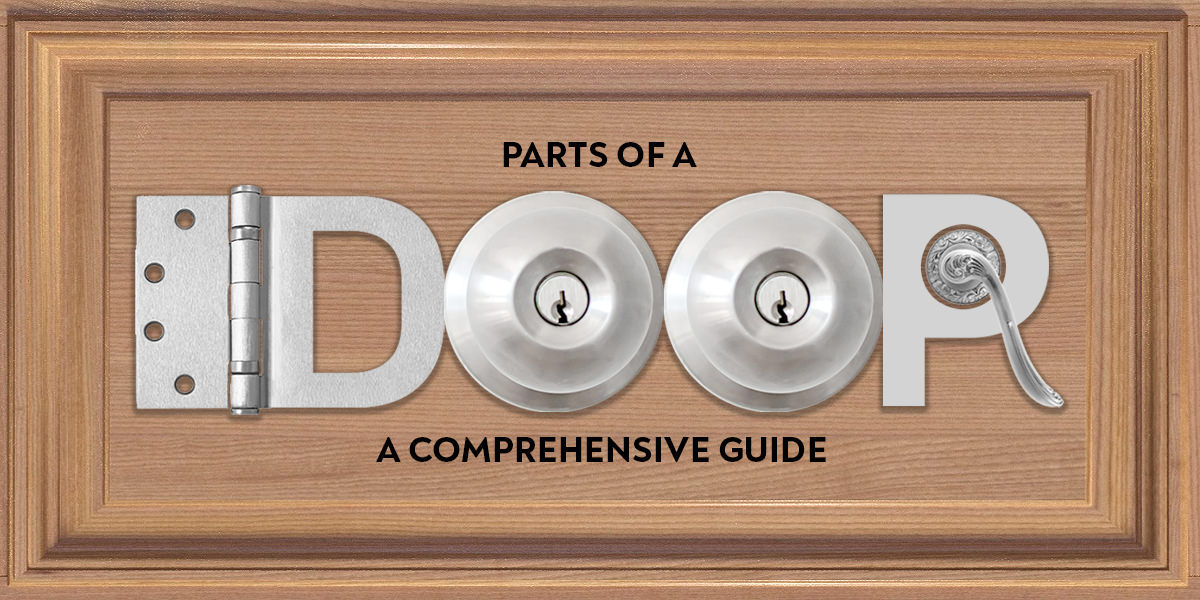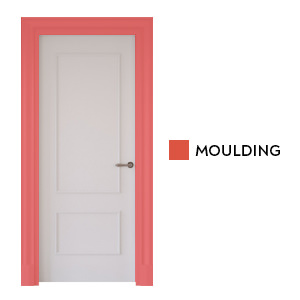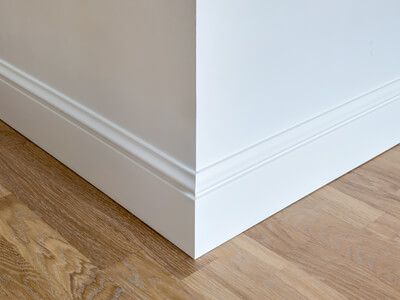
Are you often curious about the ingredients of the meal you order when dining out? If food preparations have your curiosity picked, you must surely want to know more about the deeper workings of gadgets and fixtures, especially those that call for a fair investment, a new door, for example. It always pays to know the finer aspects of things before narrowing down to the final choice. You may need to consider the door types, the material, size, colour, finish, accessories to go along with it, and so much more.
Do you want a wood, metal, or moulded door? Do you want a portion or all of it in glass? Should the glass be clear or opaque? Where will you place the door, at the entrance or in the interior? These are all questions and many more that need answers. Knowing more about your door will help you make the right choice. You will be better able to convey your needs to your interior designer, architect, or retailer and have an open discussion.
Being familiar with a door's components, what parts can be repaired, and what must be replaced, it's easy to save effort, time and money. This guide will help break down everything you need to know about a door, its parts and technical terms that may be referenced.
The major door parts are: the door slab, the door components and door hardware.

The Door Slab The door slab is the major part of a door; it is the flat rectangular part within the frame of the door. These slabs can be made of different materials like wood, fibreglass, or steel. It's like the painting canvas upon which everything else is showcased!

Stiles The vertical part of the door slab is the Stile, which usually has locks mounted near it. Stiles must measure a specific width for holding certain locking mechanisms, so it's best to measure it when installing the locks.

Rails Rails are the horizontal part of the door slab and can be both bottom and top. Rails can also have hardware mounted close to them, which must be measured when fixing connecting hardware.

Door Frame The door frame holds the central door slab in place. It has two vertical pieces called "jambs" and a single horizontal "head." The frame defines and gives structure and stability to the door.

The Jamb The vertical part of the frame is the jamb, which can be made of veneer, solid wood, or composite material.

The Sill The base of the door frame which meets the floor is called the sill. Typical to exterior doors, the Sill is usually weatherproofed to insulate the room and prevent drafts, water, or debris from getting indoors. The material can influence the strength of the frame, which ultimately impacts security. Choosing a strong, durable material, such as a composite door frame, can improve front door security.

Moulding Moulding/Trim or Casing is installed around the frame. Moulding not only covers gaps in the frame but also is a means for customisation and styling. Mouldings can come in different materials such as Pine, Oak, Aluminium, Plastic and more. Moulding also protects the door entrance by preventing moisture from seeping into the door unit.
Door Hardware

Hinges and Pivots The functionality of the door literally "hinges" on the hinges and pivots. As part of the opening and closing mechanics of the door, the hinges are usually made of anti-corrosive metal for long-term use.
In doors, hinges play a pivotal role in door styling and functionality. The part they play in the longevity of your doors is second only to the construction material and finish. The design of your door and the overlay of the face frame is the deciding factor for the type of hinge that will offer maximum functionality. Door hinges come in a host of materials, mainly steel and brass. Most standard doors require two or three hinges, or use a pivot system.

Butt/Mortise Hinges Butt hinges feature two rectangular leaves mortised into the edge of the door and the frame, allowing smooth working of the door. One of the most common door hinges, the Butt hinges come in rust-free brass or steel, with a weather-resistant coating.

Pivot Hinges Pivot hinges are marvels that allow flexibility in door design and size. Used in pivot doors, these hinges come with a top pivot that you mortise inside the door on a vertical axis. Pivot hinges may become necessary when installing heavier or full-height doors as they offer a smooth, wider range of motion in both directions.

Specialist Hinge Piano hinges, flush hinges used on light doors, and the counter flaps used on counters are all specialist in nature.
Locks and Latches

Lockset Doors not only serve as the entryway but also as a means to keep the inside of the space safe. Most doors have a lockset that works together with the handle to enable the locking and unlocking of the door. The lockset includes handles, locks, latches, strike plates and other hardware. Handles for exterior doors usually come with a thumb latch and deadbolt combination, which has a handle and secure locking mechanisms.

Deadbolt Deadbolts are thick and heavy locks designed especially to provide an additional layer of security, separate from the lockset. They are made of steel, bronze or brass, and extend deeper into the door frame. You can engage a deadbolt using a key or a turn knob, or a keyless device.

Mortice Lock The lock gets its name from the mortise or pocket cut into the door and frame into which it is fit. It is often used in traditional timber doors to maintain privacy and a high degree of protection.

Latch Latches fasten the door and are integral to a lockset. The latch mechanism is integrated with the handle within the door and retracts when a handle is turned, opening the door panel.
Door handles/Knob

Handles/Knobs Allow a comfortable grip to open and close a door. Types of handles come as Handles on Rose, Handles on Backplate, Door knobs, and others. While handles look like levers and are quite common on windows and doors, equally at home in modern door design are the circular Door knobs.
Door knobs come in different models, such as Standard Mortise Door Knobs, Rim Knobs, Passage Door Knobs, Keyed Entry Door Knobs, and Privacy Door Knobs. It's only when you browse through our website that you'll appreciate the incredible selection of door knobs and handles that are available to purchase!

Lever Handle on Backplate These handles are seen commonly seen on doors of homes and offices. They work using a simple mechanism and are easy to fit. There are several different types of the lever on backplate handles:
Lever Latch is a standard lever handle used with doors that do not need any type of locking. Such locks aid security and are locked using a key. Used with a mortise sash lock that, besides being able to open and shut the door the same as the latch version, it can also be locked by using a key.

Lever Bathroom handles Lever Bathroom handles are normally used when you are required to lock a toilet or bathroom. The handle is installed along with a bathroom mortise sash lock that allows locking the door from the inside by turning the snib. It also features a release slot on the outside handle which allows the door to be unlocked with a flat-head screwdriver. Almost every style of lever on backplate has a bathroom lever version.

Lever Handle on Rose The Lever on Rose model is yet another popular style of door handle. Modern and stylish, it comes finished in satin stainless steel, polished or satin chrome, polished nickel and many more. The lever on rose tends to be slightly more difficult to fit than the lever on backplate because the fixings which come in the form of holes around the rose can be a bit trickier to fix the door.

Mortice Door Knobs The mortice door knob is fitted to the door by screwing through the backplate of each side of the door, connected by a spindle. Some pairs of knobs also come with a grub screw under the stem of the knob, which clamps onto the spindle to strengthen the fitting. Mortice Door Knobs on Backplates are also common and are fixed to the door by screwing through the back plate.

Rim Knobs Rim Knobs are fitted with a rim lock and are common on internal doors. The rim lock fits the side of the door that opens towards you; the knobs are then fitted with the rose removed on the lock side of the door.
Additional Parts

Door Stops Door accessories and hardware includes other door furniture such as door stops. When well matched with the door and interior theme, it creates decor and functional efficiency. A door stop is one accessory which puts the finishing touches and also offers a controlled opening of the door. In case the door was to swing open too far, it may damage the adjoining wall or furniture.

Draught Excluders Draught excluders, usually a strip of rubber, brush or metal, are used to eliminate cold draughts entering through exterior doors and windows. These products are usually placed in the bottom opening where the doors meet the floor and in window cracks to provide a perfect seal to block the outdoor cold draughts, dust, water, and insects. These excluders or weather strippers not only improve energy efficiency but also the comfort of the room.

Door Closer A door closer is a device that shuts a door after it's been opened, either by a person or by mechanical means in the case of automatic doors. It gives you the convenience of auto-closing without slapping so you don't have to close the door behind you. Door closers can be concealed in the door, concealed in the floor, concealed inside the frame, and surface-mounted.
Concealed closers They are fitted into the top of the door, or inside a specially cut niche in the door frame in the case of frame-mounted models. Once the door is closed, concealed closer mechanisms are virtually invisible.

Door Holders & Checks Door holders allow doors to be kept in an open position without the use of awkward door-stops. These mechanical or magnetic checks prevent the door from slamming or swinging dangerously backward and forwards.

Floor Spring Closers Floor spring closers are fitted in a way that allows the main body of the unit to remain flush with the floor. This makes them perfect in situations where a large, bulky closure would be impossible to fit. These fixtures are visually unobtrusive, presenting only an attractive metal face plate, making them a great choice for transparent glass doors.

Overhead Door Closers An overhead door closer attaches to the top of the door, ensuring that it can't be left open accidentally and also prevents the door from slamming too quickly. Overhead models are functional and inexpensive. They're also very sturdy -- larger models can be used with heavier doors and can be surface-mounted.

Kick Plate The bottom of the door bears the maximum brunt of use, especially in high-traffic areas. A knick plate comes to the rescue-this metal or plastic plate is typically installed at the bottom of the door to protect it from scuffs, kicks, and wear and tear. Kick plates are common in commercial spaces but have become popular within homes that wish to extend the life of the door.

Peephole (Door Viewer) Peepholes are small optical devices installed in the main door, which serve as a safety tactic by allowing the people inside the home to see who is outside the door without opening the door. These are common on main doors and offer additional safety.

Muntins The frame which holds the glass panes within a window is called a muntin, muntin bar, sash bar, or glazing bar. Typically, muntins are made of wood or metal and are more common in traditional window design or French doors. These add aesthetic appeal by dividing the glass into segments instead of a single piece and also give support.

Sidelights Sidelights are narrow, vertical windows that flank the entrance door. They usually come in pairs, for use one on each side of the front door. Designed to allow natural light into the room, sidelights add functionality and appeal to the decor of the front door but may compromise privacy by offering a view of the room inside.

Transom Transom windows or transom lights sit on the horizontal beam or transom, dividing the top of a door or window from the wall above. Usually more decorative than functional, they’ve been used historically but are still relevant in modern decor. Rectangular or semicircular, usually won’t open and are designed to allow light into the room.

Flush Bolts In double doors, Flush bolts fix one door in place so the other can then be used separately.

Strike Plate The Strike Plate is a tool for reinforcing the doorjamb at the point where the latch meets the frame, for better security.

Lock Escutcheon The role of the escutcheon or keyhole cover is to conceal the keyhole on doors for a seamless finish. They are available to match the fitting of cylinders, turns and emergency turns and ensure added protection for the home or workplace.

Flush Panels Flush panels are useful in applications related to walls, fascia, and soffit to achieve a flush or flat appearance. These panels usually come in set length, so no cutting is needed at the time of installation. They are used in a concealed manner and are durably made of steel.

Raised Panels These differ from the Flush panels and have a three-dimensional profile for greater depth and detail.
Differences
What are flat and raised panels?
- Flat panels make the door flat and smooth on both sides. Flush doors are made from a single piece of wood, engineered wood or solid core. They are popular for their minimalist appearance and are designed to fit modern spaces.
- On the other hand, raised or recessed panels create stylish textures and grooves on the door's surface. These panels add a new dimension to the door surface making it aesthetically superior to flat panel models.
- Flush doors are flat and can, therefore, be easily wiped down, making maintenance a breeze. Raised panels are harder to maintain because the grooves on the door's surface can take longer to clean.
- Flush doors are one of the most popular models as they won't crack or warp easily. Raised panels are strong and durable, but seem prone to wear and tear as these have many joints.
Conclusion
Usually, end users, contractors and even designers focus more on the material, appeal and dimensions of a door and not much on the basic fabric of a door. However, your home improvement projects can get to the next level, and be more economical with a little knowledge of the anatomy of a door. By understanding the door components and their functions, from the slab and frame to panels and hinges-readers can make more informed decisions suited to their needs.
When you know what your door is made of and how it works, it helps you to stay aware and prevent installation and long-term maintenance issues, allowing you to get more bang for your buck. We at Buildworld, take pride in offering doors that prioritize quality and safety, from leading door makers. They're priced competitively and can be ordered online or bought at our well-stocked warehouse in Leicester. Shop however works best for you, and then get started on your next project.
Related Articles
Category
Study & ResearchPosted On
17th August 2023



